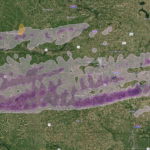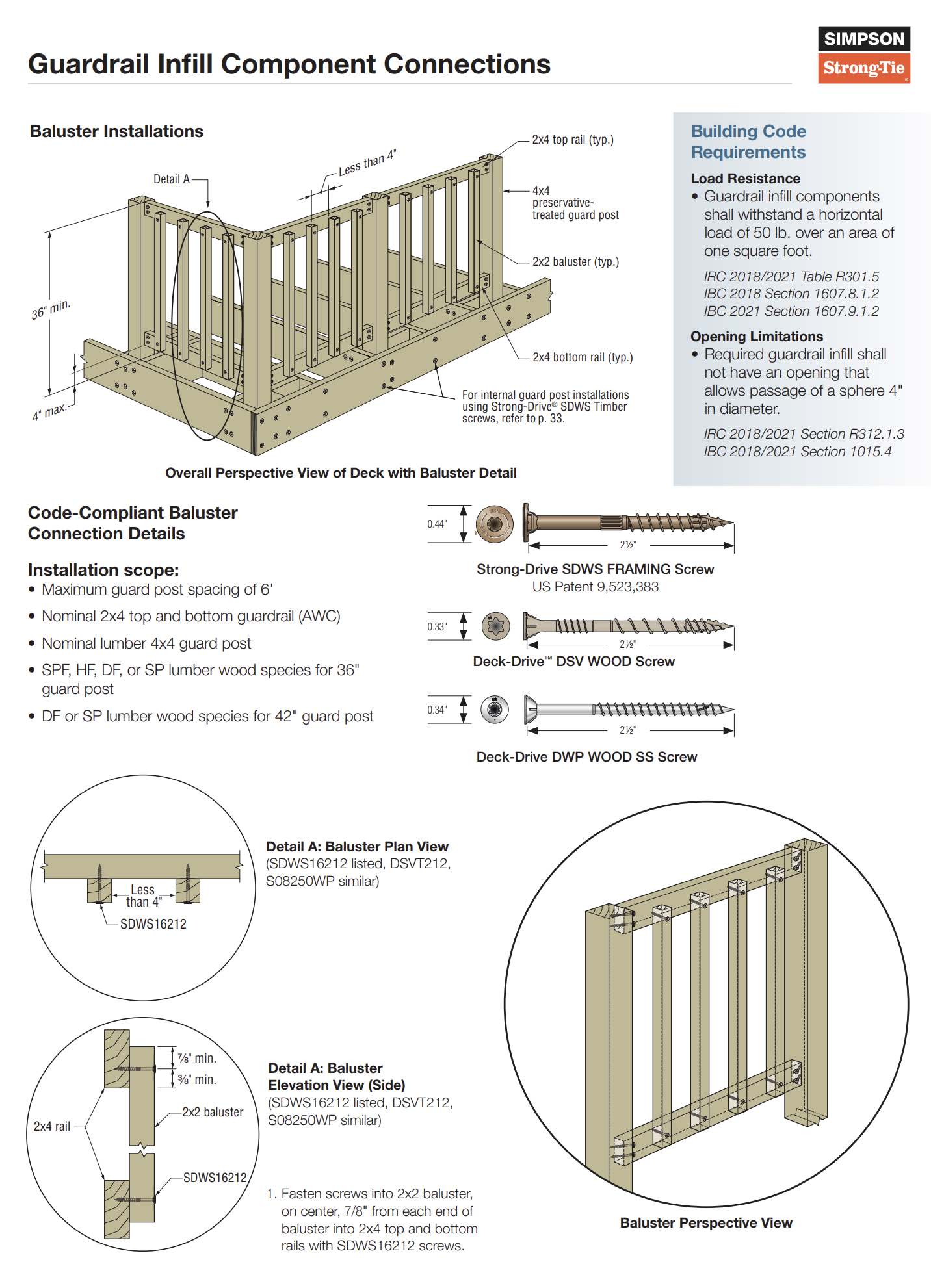Guardrail infill component connections are essential for deck safety and compliance with building codes. Proper installation using code-compliant fasteners ensures that the guardrail system can withstand the required loads and prevent accidents. This blog will cover key aspects of guardrail infill component connections, building code requirements, and the recommended solutions from Simpson Strong-Tie.
Importance of Proper Guardrail Infill Connections
Guardrail infill connections are critical for maintaining the structural integrity of the deck’s guardrail system. These connections ensure that the guardrails and balusters can resist horizontal loads and prevent openings that could allow a person or object to pass through, enhancing the overall safety of the deck.
Simpson Strong-Tie Solutions for Guardrail Infill Component Connections
Recommended Fasteners
Strong-Drive® SDWS Framing Screws
- Ideal for heavy-duty framing connections, providing high strength and durability.
Deck-Drive™ DSV Wood Screws
- Designed specifically for deck applications, offering excellent holding power and corrosion resistance.
Deck-Drive™ DWP Wood SS Screws
- Made of stainless steel for maximum corrosion resistance, suitable for preservative-treated wood and coastal environments.
Installation Scope
Guardrail Installations
- Maximum Guard Post Spacing: 6 feet
- Top and Bottom Guardrail: Nominal 2×4 lumber (AWC)
- Guard Post: Nominal 4×4 lumber
- Wood Species for 36″ Guard Post: SPF (Spruce-Pine-Fir), HF (Hem-Fir), DF (Douglas Fir), SP (Southern Pine)
- Wood Species for 42″ Guard Post: DF (Douglas Fir) or SP (Southern Pine)
Code-Compliant Baluster Connection Details
- Maximum Guard Post Spacing: 6 feet
- Top and Bottom Guardrail: Nominal 2×4 lumber (AWC)
- Guard Post: Nominal 4×4 lumber
- Wood Species for 36″ Guard Post: SPF, HF, DF, SP
- Wood Species for 42″ Guard Post: DF, SP
Building Code Requirements for Guardrail Infill Components
Load Resistance
Guardrail infill components must withstand a horizontal load of 50 lb. over an area of one square foot to ensure they can handle the pressure exerted by occupants or objects.
- IRC 2018/2021 Table R301.5
- IBC 2018 Section 1607.8.1.2
- IBC 2021 Section 1607.9.1.2
Opening Limitations
Guardrail infill must not have openings that allow the passage of a sphere 4 inches in diameter. This requirement prevents small children or objects from falling through the guardrail.
- IRC 2018/2021 Section R312.1.3
- IBC 2018/2021 Section 1015.4
Installation Tips for Guardrail Infill Components
- Measure and Mark: Ensure accurate spacing and alignment of guard posts and balusters according to the specified maximum spacing.
- Secure Fasteners: Use the recommended Simpson Strong-Tie fasteners to attach the guardrail and balusters securely to the posts and framing.
- Check for Compliance: Verify that all connections meet the load resistance and opening limitations specified in the building codes.
- Regular Inspections: Perform routine inspections to ensure all connections remain secure and free from corrosion or damage.
Conclusion
Properly installing guardrail infill components is essential for creating a safe and compliant deck. By following building code requirements and using high-quality fasteners from Simpson Strong-Tie, such as the Strong-Drive® SDWS Framing Screws, Deck-Drive™ DSV Wood Screws, and Deck-Drive™ DWP Wood SS Screws, you can ensure the safety and durability of your deck’s guardrail system. Always consult with a qualified professional to verify that your deck’s guardrail connections meet all necessary standards.
For immediate service or consultation, you may contact us at Allied Emergency Services, INC.
Contact Information:
- Phone: 1-800-792-0212
- Email: Info@AlliedEmergencyServices.com
- Location: Serving Illinois, Wisconsin, and Indiana with a focus on the greater Chicago area.
If you require immediate assistance or have specific questions, our human support is readily available to help you.
Disclaimer: This article is intended for informational purposes only. For professional advice, consult experts in the field.










